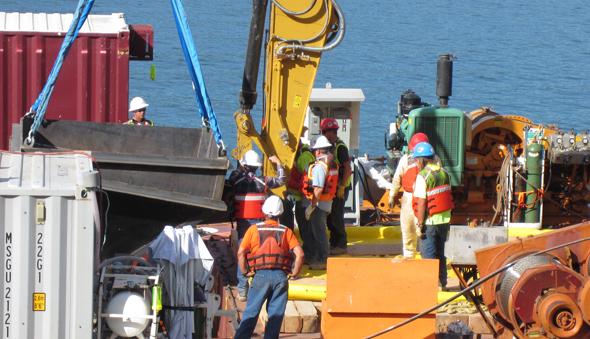Idaho River Project Highlights Environmental Values
Safe transportation of natural gas a top priority
Idaho River Project Highlights Environmental Values
The beautiful Pend Oreille River feeds Lake Pend Oreille, Idaho’s largest lake and one of the deepest inland lakes in North America. In the summer of 2013, TransCanada began work to re-establish riverbed support under a pair of natural gas pipelines that cross the Pend Oreille River, near Bonner County, Idaho, in the U.S. Pacific Northwest.
TransCanada initiated this work to ensure the continued safe and reliable transportation of natural gas to customers. The two 612-mile pipelines – known as the Gas Transmission Northwest (GTN) Pipeline System – have transported clean-burning natural gas for over half a century to customers in California, Nevada and the Pacific Northwest.
Every project undertaken at TransCanada is governed by the company’s values – Responsibility, Innovation, Integrity and Collaboration – and this important and unique maintenance project under the Pend Oreille River was no exception.
Before starting the project, nearby landowners were notified that work would take place.
“TransCanada has a very unique program in dealing with landowners during these large type projects. We get to know them quite well and we will come down and talk to them to see if there’s any concerns,”
– Steve McNulty, TransCanada land agent.
As well, TransCanada worked with the U.S. Army Corps of Engineers and the U.S. Fish and Wildlife Service to develop an innovative solution to rebuild the river bed by adding layers of pre-washed, angular-shaped natural stone pieces under the concrete-encased pipelines.
Collaboration with these agencies ensured that materials’ selection and engineering practices used throughout construction would produce the least amount of current in the river and have minimal future impact to sensitive lake resources including the threatened bull trout species. Work was done during the summer to avoid interrupting the normal, upstream migration pattern of the bull trout.
“One of the major concerns for this project from the beginning is that the area where the project is taking place is located within critically designated habitat for the bull trout,” Dean Cox, environmental specialist at TransCanada.
“In the interest of environmental stewardship and social responsibility for the area and for Lake Pend Oreille we really worked very closely with U.S. Fish and Wildlife in order to determine the proper construction practices as well as the timing for this project not to upset the annual migration of the trout through this area.”
Funds were also provided to the Idaho Fish and Game Department as part of the project’s mitigation strategy.
“Idaho Fish and Game and Cabinet Gorge Fish Hatchery would like to thank TransCanada for their donation to the hatchery operation here to help in the production of kokanee for Lake Pend Oreille,” says John Rankin of the Cabinet Gorge Hatchery in Clark Ford, Idaho.
“The money will be well used to help the bull trout in the lake, which feed on the kokanee.”
Millions of people depend on TransCanada to do its job well in order to light and heat homes, schools, hospitals, businesses and power the economy. Meeting this demand in an environmentally sustainable way is integral to TransCanada’ operations, not just today, but also in the long term.
“There is a lot of misinformation out there, so it’s important people know the strength of our commitment to environmental protection and understand how we put that commitment into action,” says Andrea Jalbert, TransCanada’s vice president of Community, Safety and Environment.
“Yes, we comply with regulations; that’s non-negotiable. But our commitment and our actions go far beyond compliance – it’s about doing the right thing.”
To achieve its goals in environmental stewardship, protection and performance, TransCanada consistently works to improve our efficiency and reduce the environmental footprint of its operations. This is achieved by using industry best practices, investing in research and development of new technology and procedures and supporting non-profit agencies that are dedicated to conserving wilderness and protecting the environment.




